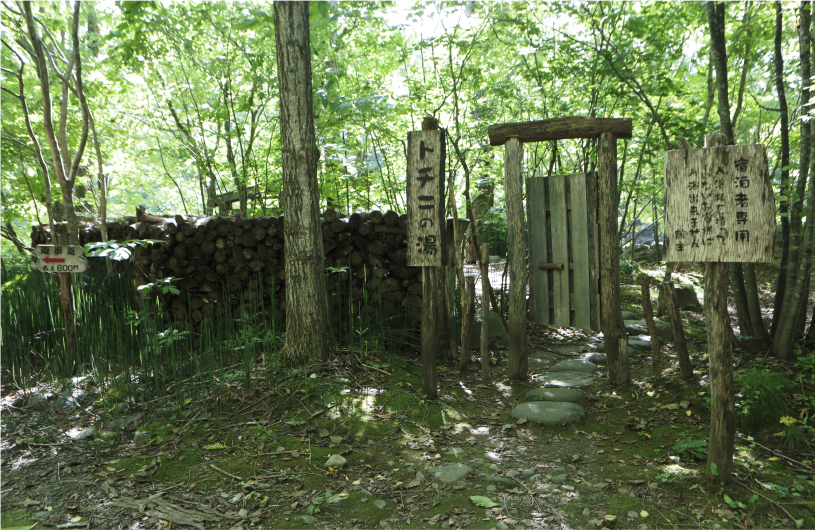
Tochini no Yu's signature "Log Bath"

Tochini no Yu's signature "Log Bath"
Ask any onsen enthusiast, and they will speak fondly of Ginkonyu. At the entrance, I was greeted with sunlight filtering through leaves and a moss-covered stone path, whisking me away into this world of tranquility and relaxation.

Overlooking the pond from the stone path, I half expected forest spirits to peer back
With five outdoor baths only available for staying guests, I knew it would take more than a day to delve into the secrets of Ginkonyu's popularity. Immediately changing into yukata, I hurried to the front desk to borrow the pass to "Tochini no Yu", the most popular bath. "Very sorry," advised the innkeeper, "most of the baths are closed today due to an outbreak of horseflies." Instead, I decided to soak in "Donguri no Yu", then stroll through the over six hectares of natural gardens.

The treehouse-like "Katsura no Yu", a three-minute walk from the inn

Scared of suspension bridges? Hate bugs? You'll do well at "Sugi no Yu", a five-minute walk from the inn

“Forest bathing” flanked by rows of katsura trees (photograph by Azusa Yajima)

Brave the suspension bridge to reach three more outdoor baths

On to "Tochini no Yu" the next morning (photograph by Azusa Yajima)
Walking through the forest was more refreshing and invigorating than I realized. The next morning, I dipped in "Katsura no Yu" and "Sugi no Yu", before making another trip at "Tochini no Yu". Fortunately, there are fewer horseflies than yesterday. I immediately took a liking to the hot waters of the log bath create a tingling sensation on the skin. Last, I entered "Momiji no Yu", which made me long for the crimson leaves of autumn. Ordinarily, so much time in hot baths would make me lightheaded, but mysteriously enough, I was perfectly fine. This was my first time to encounter an onsen that gave me such a strong feeling of the spirits of the forest.

Soak in "Tochini no Yu" (a ten-minute walk from the inn) while immersed in the sounds and fragrance of forest and stream (Photograph courtesy of Ginkonyu)
The hot springs above here originate from the sandbanks of the Otoshibe River, and are said to have been used long ago as a bathing spot by the indigenous Ainu people. In 1925, Fukutaro Kawaguchi heard of the properties of the spring water, and begun digging in search of the spring source. He struck the spring on May 10th, this fortuitous day also happening to be the silver anniversary (ginkon) of Emperor Taisho. The name stuck, and in 1927, Kawaguchi opened his hot spring lodge.

Ginkonyu, newly opened for business. Spring waters rise from the sandbank before the present-day inn. (Photograph courtesy of Ginkonyu)
Until about 25 years ago, this hot spring inn only had a simple indoor mixed-gender bath. Ginkonyu is now home to a variety of indoor baths, open-air baths, and outdoor baths fed from five hot springs, either individually or blended. The baths use absolutely no circulation, filtration, chlorine sterilization, or added tap water that could degrade the natural hot spring mineral constituents.
The source spring for "Tochini no Yu" was struck 20 years ago. The meager spring water flow rises a considerable distance from the lodge, but seeing how well-received the spring was by customers, the inn owners built a promenade and highly unique outdoor bathtub. Fourth-generation inkeeper Yohei Kawaguchi explains, "We are most proud of this breathtaking natural environment. My ancestors grew these rows of katsura trees from seed. We have nothing flashy like gold, but instead seek to offer serene and subdued 'silver-hearted' hospitality." With dedication and time, even something simple can shine with honest beauty.

The open-air bath attached to the ladies' side of the main bath hall. The water quality alone is more than enough to satisfy visitors. Even awhile after the bath, warmth lingers, promoting perspiration and skin moisture. (Photograph by Azusa Yajima)
Dining features renowned Yakumo ingredients. Mountain vegetables foraged nearby are simmered or dressed with sesame sauce. Some of the finest seafood of Funka Bay is represented by sakura flounder carpaccio, large whelks, and richly sweet botan shrimp. Local vegetable tempura is absolutely packed with flavor. Each heartwarming dish speaks of devotion and dedication, building into a crescendo of happiness. They even go so far as to feed their free-range chickens with homemade fermented feed containing no colorants, producing superbly delicious eggs.
Once you've stepped into the world of Ginkonyu, you'll find yourself longing to visit again.


Effective for: neuralgia, muscle pain, joint pain, bruises, chronic skin conditions, fatigue, chronic female disorders, cold hands and feet, cuts, burns
Hours:
Day Bathing: 12:00-16:00 (closed Monday)
Staying guest check in 13:00, check out 11:00
Rooms:
All 22 rooms are Japanese-style (16 have private toilet and vanity)
199 Kaminoyu, Yakumo, Hokkaido, Japan
Tel.: 0137-67-3111 Fax.:0137-67-3355
Website(Japanese)